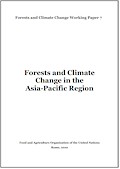| Paper |
 |
|
| Title | Forests and Climate Change in the Asia Pacific Region | | Author | Ben Vickers, Promode Kant, Rodel D. Lasco, Allison Bleaney, Sarah Milne, Regan Suzuki, Lawrence Ramos and Erica Pohnan | | Year | 2010 | | Parent Title | Forests and Climate Change Working Paper 7 | | Publisher | Food and Agriculture Organization | | City of Publication | Rome, Italy | | Pages | 108 | | Call Number | PP0303-11 |
|
| Abstract: |
There is now global consensus that climate change is a real and significant threat strongly related to anthropogenic causes. The implications are arguably even more relevant for the Asia-Pacific than other regions given its high population levels, large numbers of poor and otherwise vulnerable people and the richness of biodiversity and ecology among its highly diverse countries. It is also a region with some of the greatest potential – both in terms of carbon sequestration capacity and the human resources – to contribute to both mitigation and adaptation efforts. One of the key areas of focus on the current international climate change stage is the role of forests. The significance of
this single factor in mitigating, or potentially hastening the process of climate change, is coming to be fully realized. In light of this, and the particularly close linkage between communities in the Asia-Pacific region and the forests upon which many depend, it is imperative that forests play a central role in efforts to manage or adapt to climate change.
The development of climate change-related policies, as well as the status and approaches to forest management in the context of climate change, vary widely throughout the region. While Asia and the Pacific have seen an increase of forest cover, when disaggregated, it is clear that this is largely due to an ‘outlier’ effect – the ambitious reforestation policies of a small number of countries, namely China, India and Viet Nam. The rest of the region and Southeast Asia in particular, continue to experience high rates of deforestation.
This has implications for potential mitigation and adaptation strategies, and particularly for regional and international efforts to develop mechanisms, such as Reducing Emissions from Deforestation and Forest Degradation in Developing Countries (REDD)1 to stem the drivers of deforestation and degradation. A number of non-Annex I countries in the region, such as the Philippines and Indonesia, are being highly proactive despite having no obligation. They are undertaking emission reduction initiatives, reforestation and afforestation efforts and seeking stronger regional cooperation in tackling trans-boundary fire and pest management issues. Other countries have taken less initiative, in some cases due to limited forest area already under protected status, or preoccupation with more imminent post-conflict concerns as in the case of Afghanistan or Timor-Leste.
Capacity limitations critically restrict the degree to which countries can engage with climate change issues. There is a need to harmonize regional capacity levels and strengthen coordination and sharing of knowledge as well as mitigation and adaptation technologies. This will require financing. While this analysis indicates that there are such financing mechanisms, countries tend to perceive them as insufficient or unreliable. These factors influence the degrees to which countries integrate forestry and climate change policies within broader development frameworks.
Although forests have been recognized worldwide as a key part of the global response to climate change, many Asia-Pacific countries still have not integrated climate change strategies within national forest policies, laws and institutions. Forestry-related climate change initiatives are emerging nonetheless, and there is widespread evidence that countries are defining their own, unique country-specific strategies to harness the potential of forests for climate change mitigation and adaptation. |
|